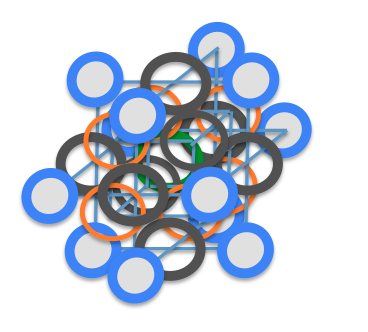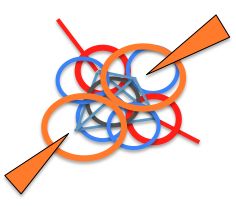Does the Atomic Nucleus Have a Lattice Structure?
The structure of the atomic nucleus had been extensively discussed since its discovery in the early 20th century. A range of different types of structures have been proposed, including gaseous, liquid, molecular cluster, solid lattice and composite types.
Solid lattice proposals to date have included different packing configurations, generally either face centred cubic (Wigner, 1937, Everling, 1958, Lezuo, 1974, Cook, 1976) or simple cubic packing (Bauer, 1985, Meissner, 2008).
Solid lattice structures have clearly shown promise, but to date limitations in data, analysis methods and models have not allowed a complete solid lattice based structural model to be developed.
Proposed Lattice Structure
Nucleus structures have been developed based on proposed non-homogenious structures for nucleons and the proposal that nuclei are comprised of nucleon composites in addition to single nucleons.
A body centred cubic packing configuration is consistent with geometries identified for neutrons and nucleon composites.
The new recognition that electron bonding configurations originate in the nucleus provides further information on possible nucleus structures.
Structures are developed by recognising that elemental patterns identified in chemistry have their basis in the nucleus. As a consequence, nucleus packing configurations and preferencing is expected to have similar patterns to chemical elements.
Structures are alpha particle based, with nucleons composite containing upto 2 protons and 2 neutrons. Partly filled composites are also possible, (2p, 1n), (1p, 2n), (1p, 1n) and 2n.
Shells based configurations are proposed, with lattice based geometries for each shell being identified.
Shells are identified as:
- (i) Inner "s" shell, 1 composite,
- (ii) "p" shell, 8 composites, in a 2x2 cubic arrangement,
- (ii) "d" shell, 18 composites, forming a truncated 3x3 cubic arrangement, 12 edges, 6 face-centred,
- (iv) "f" shell, 32 composites, forming a 5x5 truncated cubic arrangement, 6x4 face-centred, 8 at corners,
i.e. for Radon:
86 = 27x2+32 = 1x2 (s) + 8x2 (p) + 18x2(d) + 6x4x1 + 8x1,
- (v) outer shell, 50 or more neutrons, cubic, with truncated corners and edges, 12 edges, 5x6 face centred, 8 at corners,
Generally each shell is firstly fully filled with individual nucleons, then with (1p, 1n) composites, before final filling to (2p, 2n).

Copyright S. Brink.
Simple Cubic Packing Arrangement

Copyright S. Brink.
Body Centred Cubic Packing
Noble (Inert) Gases
Noble (inert) gases are unique as they form almost no chemical compounds with other elements. The proposed magnetic bonding relationship between chemical bonding orientations and nuclei structures suggests a special symmetry for Noble gas nuclei.
Proposed nuclei structures are generally similar to geometries proposed by Cook (1978), but incorporate composites of up to four nucleons, and are based on body centred cubic rather than face centred cubic packing.
Proposed structures are unique as they have no external north poles, allowing minimal opportunity for bond formation beyond basic dimers (He2, Ne2, Ar2, etc.).

Neon 20
Hydrogen 2
Helium 4



s: 2p, 2n
s: 1p, 1n
s: 2p, 2n
p: 1p, 1n
Copyright S. Brink.
Copyright S. Brink.
Copyright S. Brink.
Note: Deuterium is not classified
as a Noble gas.
Xenon 136
Argon 36
Krypton 86



s: 2p, 2n
d: 2p,2n
s: 2p, 2n
s: 2p, 2n
d: 1p,1n
p: 2p, 2n
Copyright S. Brink.
f: 1n
p: 2p, 2n
Copyright S. Brink.
p: 2p, 2n
Copyright S. Brink.
f: 1n
Radon 222
Oganesson 294


s: 2p, 2n
d: 2p,2n
s: 2p, 2n
d: 2p, 2n
p: 2p, 2n
Copyright S. Brink.
f: 1p, 1n
p: 2p, 2n
Copyright S. Brink.
f: 2p, 2n
Note: Four atoms detected to date.
Alkali Metals (Group I)

Viable structures for Group I structures can be developed, based on these modelling principles.
Group I elements are unique as they highly electropositive, forming ionic bonds and crystaline salts with electronegative elements.
Proposed nucleus structures for various Group I element nuclei are shown below:
Sodium 23
Lithium 6
Lithium 7



Copyright S. Brink.
Copyright S. Brink.
Copyright S. Brink.
Potassium 41
Potassium 39
Potassium 40



Copyright S. Brink.
Copyright S. Brink.
Copyright S. Brink.
Cesium 133
Rubidium 85
Rubidium 87



Copyright S. Brink.
Copyright S. Brink.
Copyright S. Brink.
Alkaline Earth Metals (Group II)
Group II elements are typically metals, forming two metallic, two covalent or one double bonds to adjacent atoms.
Proposed nuclei structures are shown below:
Beryllium 9
Magnesium 24
Magnesium 25



Copyright S. Brink.
Copyright S. Brink.
Copyright S. Brink.
Magnesium 26
Calcium 40
Calcium 42



Copyright S. Brink.
Copyright S. Brink.
Copyright S. Brink.
Calcium 43
Calcium 44
Calcium 46



Copyright S. Brink.
Copyright S. Brink.
Copyright S. Brink.
Strontium 84
Strontium 86
Strontium 87



Copyright S. Brink.
Copyright S. Brink.
Copyright S. Brink.
Strontium 88
Barium 132
Barium 134



Copyright S. Brink.
Copyright S. Brink.
Copyright S. Brink.
Barium 136
Barium 138
Radium 226



Copyright S. Brink.
Copyright S. Brink.
Copyright S. Brink.
Halogens
Halogens are highly electronegative elements, forming ionic and covalently bonded compounds, typically with electro positive elements, such as alkali metals (Group I), alkaline earth metals (Group II) and other metals.
Fluorine 19
Chlorine 35
Chlorine 37



Copyright S. Brink.
Copyright S. Brink.
Copyright S. Brink.
Bromine 79
Bromine 81
Iodine 127



Copyright S. Brink.
Copyright S. Brink.
Copyright S. Brink.

Transition Metals
Nuclei structures for elements of the first transition metal series are based around a central alpha group, a cubic structure of 8 additional alpha groups, then additional composites being added at cube faces.
Scandium 45
Titanium 46
Titanium 47



2p, 2n at centre
2p, 2n at centre
2p, 2n at centre
Copyright S. Brink.
Copyright S. Brink.
Copyright S. Brink.
Titanium 48
Titanium 49
Titanium 50

2p, 2n at centre


2p, 2n at centre
2p, 2n at centre
Copyright S. Brink.
Copyright S. Brink.
Copyright S. Brink.
Vanadium 50
Vanadium 51
Manganese 53
2p, 2n at centre


1p, 1n at centre

2p at centre
Copyright S. Brink.
Copyright S. Brink.
Copyright S. Brink.
Manganese 55
Iron 54
Iron 56

1p, 2n at centre


2p, 2n at centre
2p at centre
Copyright S. Brink.
Copyright S. Brink.
Copyright S. Brink.
Iron 57
Iron 58
Cobalt 59

1p,2n at centre


2p,2n at centre
2p,2n at centre
Copyright S. Brink.
Copyright S. Brink.
Copyright S. Brink.
Nickel 58
Nickel 60
Nickel 61

2p,2n at centre
2p at centre

2p,2n at centre

Copyright S. Brink.
Copyright S. Brink.
Copyright S. Brink.
Nickel 62
Nickel 64
Copper 63

2p,2n at centre


2p,2n at centre
1p,2n at centre
Copyright S. Brink.
Copyright S. Brink.
Copyright S. Brink.
Copper 65
Zinc 64
Zinc 66



1p,2n at centre
2p,2n at centre
2p,2n at centre
Copyright S. Brink.
Copyright S. Brink.
Copyright S. Brink.
Zinc 67
Zinc 68
Zinc 70

2p,2n at centre

2p,2n at centre

2p,2n at centre
Copyright S. Brink.
Copyright S. Brink.
Copyright S. Brink.

Other Atomic Nuclei
Viable nuclei structures can be developed for other atomic nuclei with geometries that are appear consistent with relative isotope stabilities, isotopic abundances and observed chemical properties.
Examples include:
Boron 10
Boron 11
Carbon 12



Copyright S. Brink.
Copyright S. Brink.
Copyright S. Brink.
Carbon 14
Nitrogen 14
Oxygen 16



<--- lone pair orientation
Copyright S. Brink.
Copyright S. Brink.
Copyright S. Brink.
Aluminium 27
Silicon 28
Silicon 29

Copyright S. Brink.
Copyright S. Brink.
Copyright S. Brink.
Silicon 30
Phosphorous 31
Sulfur 32


Copyright S. Brink.
Copyright S. Brink.
Copyright S. Brink.
Sulfur 33
Sulfur 34
Sulfur 36



Copyright S. Brink.
Copyright S. Brink.
Copyright S. Brink.
Nucleus structures directly match
chemical bonding configurations !!!